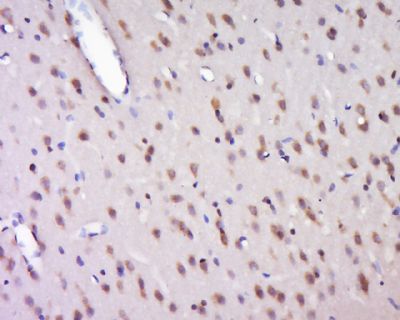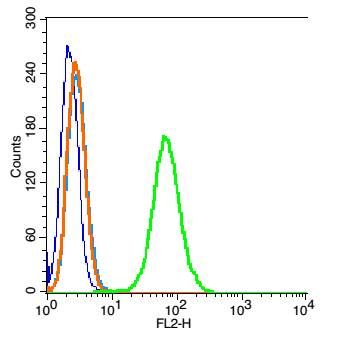HELZ Polyclonal Antibody
Purified Rabbit Polyclonal Antibody (Pab)
- SPECIFICATION
- CITATIONS
- PROTOCOLS
- BACKGROUND

Application
| IHC-P, IHC-F, IF, ICC, E |
|---|---|
| Primary Accession | P42694 |
| Reactivity | Rat |
| Host | Rabbit |
| Clonality | Polyclonal |
| Calculated MW | 219 KDa |
| Physical State | Liquid |
| Immunogen | KLH conjugated synthetic peptide derived from human HELZ |
| Epitope Specificity | 1-100/1942 |
| Isotype | IgG |
| Purity | affinity purified by Protein A |
| Buffer | 0.01M TBS (pH7.4) with 1% BSA, 0.02% Proclin300 and 50% Glycerol. |
| SUBCELLULAR LOCATION | Nucleus (Probable). |
| SIMILARITY | Belongs to the DNA2/NAM7 helicase family.Contains 1 C3H1-type zinc finger. |
| SUBUNIT | Interacts with SMYD2 (By similarity). Interacts with POLR2A. Interacts with SMYD3; the interaction may bridge SMYD3 and RNA polymerase II. |
| Important Note | This product as supplied is intended for research use only, not for use in human, therapeutic or diagnostic applications. |
| Background Descriptions | Helicases comprise a class of enzymes that function as motor proteins which move along nucleic acid phosphodiester bonds, effectively separating two annealed nucleic acid strands. RNA helicases alter the conformation of RNA, specifically by unwinding double-stranded RNA regions to yield single RNA strands, a process which changes the biological activity of the RNA molecule. HELZ (helicase with zinc finger), also known as DHRC or HUMORF5, is a 1,942 amino acid nuclear protein that contains one C3H1-type zinc finger and belongs to the RNA helicase superfamily. Expressed ubiquitously during embryonic development, HELZ is thought to function as an RNA helicase that modifies RNA structure and plays a role in the development of multiple organs and tissues within the developing embryo. |
| Gene ID | 9931 |
|---|---|
| Other Names | Probable helicase with zinc finger domain, 3.6.4.-, Down-regulated in human cancers protein, HELZ, DRHC, KIAA0054 |
| Target/Specificity | Expressed predominantly in thymus and brain. Expression is down-regulated in 28 of 95 tested cancer cell lines. |
| Dilution | IHC-P=1:100-500,IHC-F=1:100-500,ICC=1:100-500,IF=1:100-500,Flow-Cyt=1 µg/Test,ELISA=1:5000-10000 |
| Storage | Store at -20 ℃ for one year. Avoid repeated freeze/thaw cycles. When reconstituted in sterile pH 7.4 0.01M PBS or diluent of antibody the antibody is stable for at least two weeks at 2-4 ℃. |
| Name | HELZ |
|---|---|
| Synonyms | DRHC, KIAA0054 |
| Function | May act as a helicase that plays a role in RNA metabolism in multiple tissues and organs within the developing embryo. |
| Cellular Location | Nucleus. |
| Tissue Location | Expressed predominantly in thymus and brain. Expression is down-regulated in 28 of 95 tested cancer cell lines |

Thousands of laboratories across the world have published research that depended on the performance of antibodies from Abcepta to advance their research. Check out links to articles that cite our products in major peer-reviewed journals, organized by research category.
info@abcepta.com, and receive a free "I Love Antibodies" mug.
Provided below are standard protocols that you may find useful for product applications.
If you have used an Abcepta product and would like to share how it has performed, please click on the "Submit Review" button and provide the requested information. Our staff will examine and post your review and contact you if needed.
If you have any additional inquiries please email technical services at tech@abcepta.com.













 Foundational characteristics of cancer include proliferation, angiogenesis, migration, evasion of apoptosis, and cellular immortality. Find key markers for these cellular processes and antibodies to detect them.
Foundational characteristics of cancer include proliferation, angiogenesis, migration, evasion of apoptosis, and cellular immortality. Find key markers for these cellular processes and antibodies to detect them. The SUMOplot™ Analysis Program predicts and scores sumoylation sites in your protein. SUMOylation is a post-translational modification involved in various cellular processes, such as nuclear-cytosolic transport, transcriptional regulation, apoptosis, protein stability, response to stress, and progression through the cell cycle.
The SUMOplot™ Analysis Program predicts and scores sumoylation sites in your protein. SUMOylation is a post-translational modification involved in various cellular processes, such as nuclear-cytosolic transport, transcriptional regulation, apoptosis, protein stability, response to stress, and progression through the cell cycle. The Autophagy Receptor Motif Plotter predicts and scores autophagy receptor binding sites in your protein. Identifying proteins connected to this pathway is critical to understanding the role of autophagy in physiological as well as pathological processes such as development, differentiation, neurodegenerative diseases, stress, infection, and cancer.
The Autophagy Receptor Motif Plotter predicts and scores autophagy receptor binding sites in your protein. Identifying proteins connected to this pathway is critical to understanding the role of autophagy in physiological as well as pathological processes such as development, differentiation, neurodegenerative diseases, stress, infection, and cancer.



